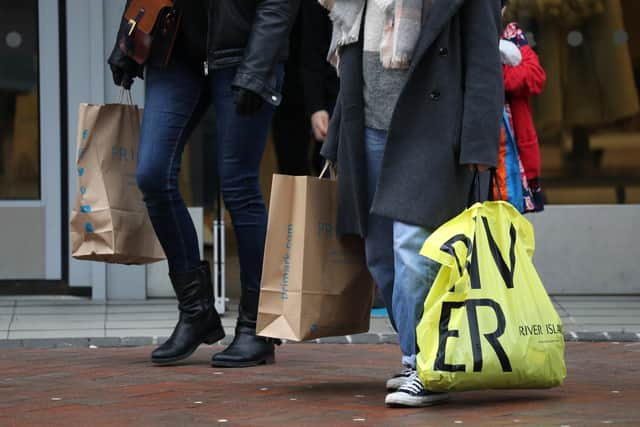Scottish economy to return to growth in 2024 as consumer spending rebounds - EY Item Club
Publishing its latest Scotland Forecast report, the EY Item Club said gross value added (GVA) was expected to increase by 1.6 per cent over the course of 2024, helped by a 2.3 per cent increase in consumer spending, as employment and real wages recover. GVA is an alternative to using gross domestic product (GDP) to measure economic output, with some technical distinctions.
The report predicts that Scottish GVA will fall by 0.6 per cent in 2023, with that decline largely concentrated in the first half of the year. Some sectors can expect to see growth, led by health and social care (up 1.2 per cent), education administrative and support services (1.1 per cent), and public administration (0.8 per cent). Marginal rises are also forecast in the professional, scientific, and technical sector (0.3 per cent), as well as in construction (0.1 per cent).
Advertisement
Hide AdAdvertisement
Hide AdEY noted that Scotland’s economy grew strongly in 2021 as it recovered from the pandemic, before slowing in the second half of last year. The Item Club estimates that Scotland’s GVA rose 5.3 per cent in 2022, a slowdown from 7.9 per cent in 2021, with 2022’s growth concentrated in the year’s first half. It comes as new Scottish Government GDP figures show that the economy grew by 0.9 per cent during the first month of 2023, after falling by 0.8 per cent the previous month, and is now 1.1 per cent above the pre-pandemic level of February 2020. Meanwhile, the Office for Budget Responsibility recently predicted that the UK economy would avoid a technical recession - two consecutive quarters of decline - in 2023, though it is still expected to contract by 0.2 per cent, before gathering pace next year.
Ally Scott, EY Scotland regional managing partner, said: “While challenging conditions are expected to stretch into the summer of 2023, we are starting to see signs in a number of areas which give cause for optimism - energy prices are falling and the economy has proved to be more resilient than expected. A return to calendar year growth is forecast in 2024, but Scotland will continue to face some long-term challenges in demographics, such as the profile of our working-age population. However, there are also some exciting opportunities that must be grasped if Scotland is to catch the next bounce of the ball in terms of local economic growth.
“Growth opportunities can be created by building on Scotland’s world-class strengths in financial services, life sciences, software and technology. There are also clear natural advantages in navigating the transition to net zero - by industry and society - using established and emerging skills to move from traditional hydrocarbons and towards clean energy and renewables. It’s important we create an economic environment which inspires confidence to invest and grow differentially once more. We know this can generate strong positivity across Scotland, especially when coupled with our high attractiveness - both globally and within the UK - as a place to live, work and do business.”
The Item Club said Scotland’s economic performance over the past year broadly mirrored the experience of the UK, and of much of the rest of the world, and reflected the impact on the global economy caused by the conflict in Ukraine and its consequences for confidence, supply chains, and energy prices and inflation. Based on the latest forecast, it will be 2025 before Scotland’s GVA is expected to finally climb above where it was pre-pandemic.
Sue Dawe, head of financial services for EY Scotland, said: “Conditions have been up and down since the middle of last year, and it’s anticipated that consumers will make more use of savings accumulated during the pandemic throughout 2023. However, net savings are a diminishing asset, especially in a year in which borrowing has become very expensive due to higher interest rates. That said, recent declines in some prices suggest that inflation will weaken during this year and, if it falls as quickly as the EY Item Club expects, there is a good chance interest rate cuts may be on the menu by the end of this year.”


According to the latest forecast, the majority of sectors are likely to experience rising output in 2024 and beyond. The sector that is projected to lead the way is information and communications, reflecting a similar story at UK level. Also likely to be experiencing stronger-than -average growth in 2024 are accommodation and food services, and arts, entertainment and recreation, as these sectors rebound from 2023. Experts said those areas should benefit from a combination of continuing improvements in visitor numbers, increased lengths of stay, as well as increased spending by Scottish residents, as the cost-of-living crisis eases.
Another sector that is expected to experience above-average growth is professional, scientific and technical services. Like information and communications, this sector is on a long-term upward trend, EY noted, and is also a sector in which customers often look to local suppliers. As such, Scottish companies in the sector are likely to benefit from the overall rise in demand from their home market in 2024.
The Item Club research suggests that consumer sentiment will remain a key point of focus. High inflation will continue to squeeze real disposable incomes this year, and the report forecasts a fall in consumer spending. But as inflation cools throughout 2023, the drag on real incomes should begin to abate, it believes. Last year saw a decline in Scottish business confidence, mirroring the fall in consumer confidence.
Comments
Want to join the conversation? Please or to comment on this article.